Salt scares me and yet I adore it. I crave the crunch of flakes of sea salt on a sliver of perfectly ripe avocado. I am in awe of the way a flake of Maldon sea salt can turn a square of Valrhona dark chocolate into a bite of caramelized heaven in my mouth. Yet I’m not afraid of this amazing crystalline structure packed with minerals and nutrients when I’m cooking for myself. Nope. It’s just when others are involved.
We’re often taught that it’s rude to ask for salt in a restaurant in case we offend the chef. Occasionally when I’m cooking for friends, a guest will unabashedly ask me to “Hold the salt, please”. And of course, there’s the message from the medical community that salt can be bad for your health, causing everything from high blood pressure to stomach cancer. Praise the heavens that the tide seems to be turning on some of those negative health arguments.
So it’s with both anticipation and trepidation that I sit with about 15 other women in the sunny courtyard at Pizzaiolo in Oakland, CA, on a summer Sunday afternoon. We are here to learn about salt from talented cook, Samin Nosrat, a vivacious, generous and open-hearted teacher who donned her first apron in Alice Waters’ kitchen at Chez Panisse. She starts our four hours together by passing around two plates of sliced, juicy, farm-fresh tomatoes: one plate is salted, the other isn’t. “The secret to cooking with salt,” she shares, “is to use just enough that you bring the flavor of the food to its very edge.” Apparently, if you get this right you won’t taste the salt at all. But, I wonder, how do you get it right?
First we learn about types of salts. Samin passes around glass mason jars each filled with a different salt. There’s an array of colors: from grey, to snow-white to a dusky pink. A host of different shapes: one salt feels grainy and damp to the touch like sand, another hard and rock-like, and yet another consists of feather-light flakes. Samin urges us to pop the grains on our tongue: some taste strongly of the sea, while others are more smoky, almost sweet.
She warns us to avoid iodized salt – many experts believe we get enough iodine through our food if we eat a healthy diet and don’t need any extra – and instead use a quality kosher salt when cooking like Morton’s. It’s also worth having a great ‘finishing’ salt on hand – typically more pricey – that can be liberally sprinkled over a completed dish to really push the flavor. My personal favorite is Maldon’s, no doubt because it’s British, but fleur de sel, traditionally hand-harvested from Brittany in France, and damp sel gris, also known as Celtic sea salt, are all great options. Someone asks about pepper and Samin is quick to point out that it’s a spice. Entirely different. In her opinion we should make a considered decision about whether a dish calls for pepper, not just assume the two are married and always use them together.
Samin guides us through some basics about salt and how to use it. She reveals that not all salts are equally salty and in fact, saltiness is determined by weight, not volume, rendering virtually useless recipe instructions that call for salt by the spoonful. A lesson on osmosis follows and memories of sitting in a holey, blue cotton overall at a well-worn wooden bench in my high school chemistry lab come flooding back. She explains that the key to locking-in and enhancing the flavor of any ingredient, from a whole chicken to a green bean, is to ensure that there’s enough salt on the outside – in the boiling water or on the skin – to prevent all the salts and nutrients from leaching out.
With some theory under our belts, we head out of the sunshine and into the restaurant’s dimly lit kitchen with its line of blackened stove tops and armory of battered pans. The plan is to conjure up a feast of roast chicken with caramelized onions and green beans, along with a tomato, lemon cucumber and little gem salad. For dessert, Three Twins vanilla ice cream paired with homemade salted caramel sauce. Every dish will require an expert hand salting it to perfection. But we’ll be doing the cooking, so the salting may not be that expert after all.
As Samin walks us through the menu, she reminds us to use all our senses when cooking, not just the obvious ones but also touch. “Throw away your salt shakers,” Samin urges us. “Instead, use a bowl that’s big enough to put your whole hand in so you can really feel the weight of the salt. Ideally keep one hand dry so the salt doesn’t stick to your fingers.” Easier said than done. She demonstrates how to evenly salt a dish by scooping up a handful of dazzling white grains and scattering them as if sowing seed. The entirely wrong way is to grab a pinch of salt between your thumb and forefingers as I have for 30 plus years, as this only allows for a miserly action. (Unless of course, the recipe calls for a pinch of salt, in which case you need to know how salty your salt is and whether a pinch is really enough. Yup, this is a fine art.)
Samin pulls out her knife and ever generous with her knowledge, before slicing the first onion, shows us how to correctly hold the knife with a finger along the top of the blade to ensure it’s evenly weighted. “Keep your shoulder and elbow loose and relaxed,” she urges. “Otherwise it’ll be hard to cut evenly.” Next she shows how to slice an onion so every piece is exactly the same [I’ll write a post on this in the future]. I discover, yet again, that I’ve been doing it all wrong.
At every opportunity we experiment. We caramelize one pan of onions without salting them first and they darken very quickly, while in the other pan, the onions have been liberally salted and take longer to turn a shade of pale gold. It turns out this is because the salt draws water out of the onions, creating steam and slowing down the process. We roast four chickens. Two have been salted the day before, and the other two just before going into the flaming hot oven. We learn how to put so much salt in a pot of boiling water for green beans you could almost stand a spoon in the water.
It turns out that you almost always add WAY more salt than you’d imagine could be legal. I said almost always. My job is to salt the tomatoes. Hard to go wrong here, I think to myself. After all, tomatoes and salt go together like a horse and carriage. Apparently you can’t be literal about salt. When Samin says you generally use twice as much salt as you’re used to using, she doesn’t actually mean use twice as much.
I eagerly scoop and scatter salt across the huge earthen bowl filled to the brim with cherry tomatoes that have been painstakingly halved by one of my classmates. I feel so liberated from my fear of salt that I forget to taste as I go. Just in the nick of time, someone suggests I stop for a second and see whether I’ve added enough. Oh no! It almost tastes too salty – even for me, a lover of salt. My fear of salt immediately surges back like a powerful wave. Samin tastes the tomatoes herself and tells me in a kindly voice to put down the salt. I comply immediately.
Finally, we sit down to eat at two long tables set up in the back room of the restaurant. We are proud of the fruits of our labor and eager to compare and contrast the results of our experiments. The chicken that was salted well in advance is a little more moist, although the chicken that was seasoned just before cooking tastes pretty darn good to me. It’s hard to restrain from seconds and then thirds of the caramelized onions. They are simply delicious, almost-creamy in texture. The green beans are sweet and tender. The tomatoes, well they’re passable. And the dessert! Grabbing a bowl and spoon, I treat myself to a little ice cream with my salted caramel sauce. [I’ll share the method and recipe soon]. Stuffed to the gills, I pack up a little take-home box so my son can taste how I spent my afternoon and head off back over the Richmond Bridge, my head spinning with all that I’ve learned.
One of the secrets I take away with me is to salt meat well in advance of cooking. Samin recommends salting it as soon as you get home from the store or market, before you put it in the fridge. The same is true for marinades that contain salt, such as soy sauce, even if you don’t plan to cook the meat for two or three days. So back at home a few days later, I try out my new acquired salting skills on a simple roasted chicken and the results are amazing. The meat is juicy, succulent even, and very tender to the bite. My guests give the chicken rave reviews and immediately want to know how to apply the salt. How much? Do you rub it in? Do you put it inside the bird? The answer is: liberally scatter the salt all over, not forgetting the underside and give it as long as possible to do its work.
I learned more about food, taste and of course, salt, in one afternoon than I thought possible and will share more in the future. If you’d like to experience Samin’s magic firsthand, she will be teaching classes at the new San Francisco Cooking School. (Look for a future interview with the School’s founder Jodi Liano).
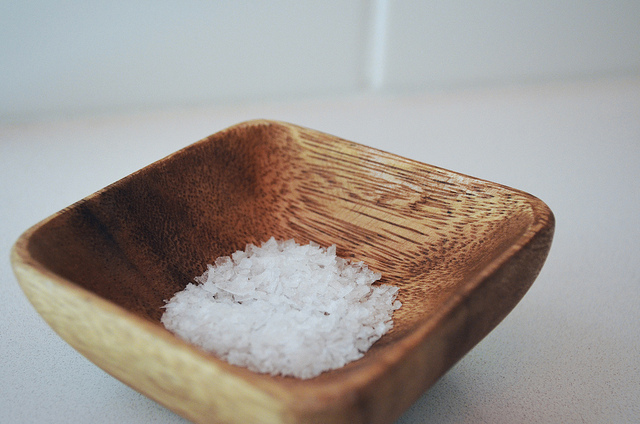
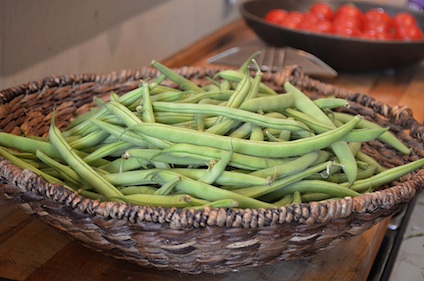



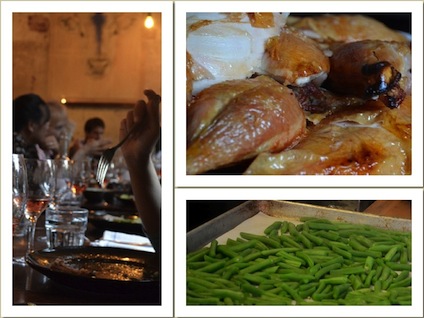


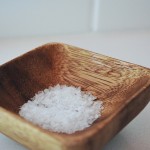
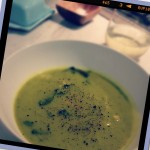
Great post, Alice. I learned a lot. 🙂
This one was really nicely done and very informative, especially to someone like me who likes a salt shaker close at hand when it’s time to eat. The photos are terrific and add to the reading experience. Now you need to figure out how to attach cooking smells to your entries….
Maybe a silly question but do you wash the chicken before seasoning it?
Hi there, I think that’s a personal choice – I don’t wash the chicken. But if you want a nice crispy skin be sure to pat it dry before you season.
Fruit fool – foole – was first mentioned in 1598 with gooseberries yuk. And was with luscious custard instead of cream. Oh yum. Do you still eat puddings with lashings if hot runny custard. :'( I want rhubarb fool and I want sticky toffee pud with custard and I live in a God forsaken country that has no real custard. I could easily move to the USA just for the food in the supermarkets. Oh woe is me for I am undone.
Were the onions that were salted beforehand and took longer to cook better/more caramelized than the others?
Good question… it was a while ago – but if I remember correctly, yes, the salt draws out the water, which means the don’t burn and instead caramelize slowly.